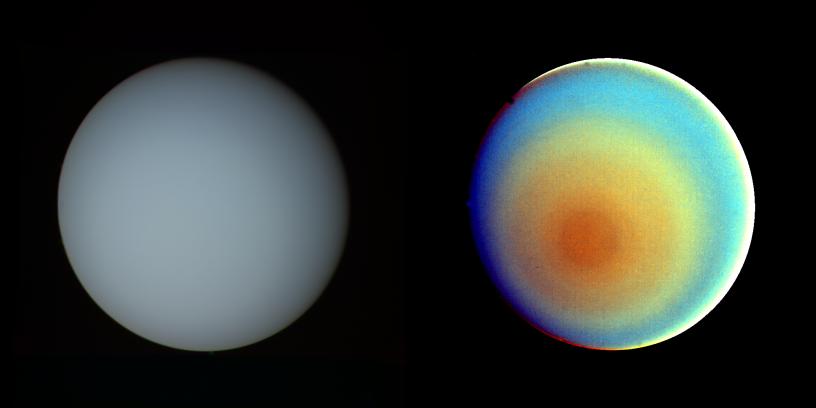[/caption]
Uranus is a ball of ice and gas, so you can’t really say that it has a surface. If you tried to land a spacecraft on Uranus, it would just sink down through the upper atmosphere of hydrogen and helium, and into the liquid icy center.
When we look at Uranus, we see the blue-green color that seems to come from the surface of Uranus. This color is light from the Sun reflected off Uranus’ surface. The atmosphere of Uranus contains hydrogen and helium, and most importantly, it has relatively large amounts of methane. This methane absorbs color in the red end of the spectrum of light, while photons at the blue end of the spectrum are able to reflect off the clouds and go back into space. So the full spectrum of the Sun’s light goes in, the red and orange end of the spectrum is absorbed, and the blue green end of the spectrum bounces back out. And this is why the surface of Uranus has its color.
But let’s imagine that the surface of Uranus was actually solid, and you could walk around. You might be surprised to know that you would only experience 89% the gravity that you feel back on Earth. Even though Uranus has 14.5 times more mass than Earth, it has 63 times the volume of Earth. Uranus is the second least dense planet in the Solar System, so it has a relatively weak gravity on its surface.
We have written several articles about Uranus for Universe Today. Here’s a story about what’s inside a gas giant, and here’s one about two new moons discovered for Uranus.
If you’d like more info on Uranus, check out Hubblesite’s News Releases about Uranus. And here’s a link to the NASA’s Solar System Exploration Guide to Uranus.
We have recorded an episode of Astronomy Cast just about Uranus. You can access it here: Episode 62: Uranus.

